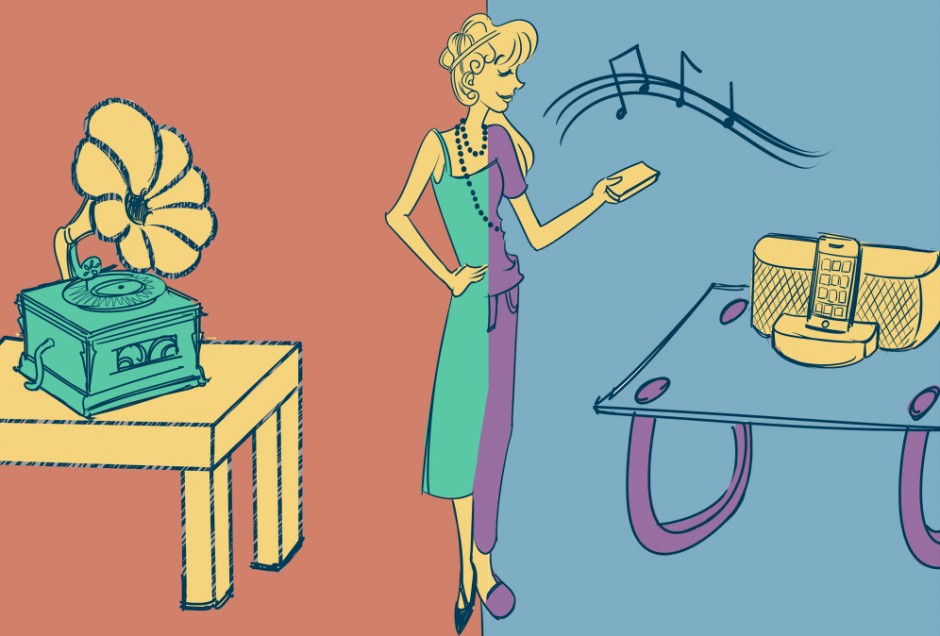The Internet and the digital age have been heralded as incredible forces that democratize music, destroying musicianship as a profession through the rise of illegal downloads. Much of the discourse surrounding its role in today’s music industry assumes that the only way people access music is through their laptop.
I’ve always struggled with this idea. I’ve been buying records since before I even had a way to play them, amassing a collection of physical objects lovingly made by bands that I believe in. I also own an iPod, switching between shuffling through playlists and placing the needle on an entire body of work.
Digital and analog co-exist in many people’s listening habits and also in the success of Toronto’s record stores and the number of musicians who release material in both ways.
Records, community, and art
Vinyl sales are rising, a fact driven home every December as countless news outlets and blogs print stories announcing the format’s resurgence. This is not a case of pure nostalgia; much of today’s record-toting population never lived at a time when records were the primary form of music consumption.
The existence and thriving of local record stores is an indication that people are maintaining their relationship with analog. Ian Cheung and Dennis Reynolds founded June Records in 2012 out of a love for the vinyl format. Unlike other stores that feature books, t-shirts, or concert tickets to pull in an audience, the store focuses almost exclusively on records and hosts a large number of in-store performances and events to support and stay connected with Toronto’s music community.
Cheung has a lot to say about why people still listen to vinyl despite the proliferation of mp3s and other digital formats. He points to the fantastic sound as an important reason why the format has endured. Records also provide important context for music that is hard to recreate through a computer screen.
“You get a lot of knowledge and information from the liner notes,” he says. “If you’re really into this one piece of music, you are pointed down paths where you can find more of that kind of stuff.”
Reading the liner notes places you within the musical context without having to wind through Wikipedia links — as Cheung points out, you’re already holding the record in your hands after placing it on the turntable, so you might as well learn something about the soundtrack you have selected.
There’s also a built-in opportunity to appreciate the wider context of an album, a concept that is still going strong despite an iTunes-driven push towards singles. Cheung says, “You’re not just focused on the hits. If you connect with the artist’s expression and the way that they communicate that, then those other songs are going to be rewarding too.”
Physical media are beneficial from a musician’s perspective as well. Brandon Gibson-DeGroote is one half of local independent pop band Most People, who release their music on CDs in order to have something to offer at live shows.
“Emotionally, I think you connect to it differently,” he says. “Even though you consume music digitally now, when you are out physically experiencing a show, you want to have the actual object.”
Collecting actual objects allows you to treasure the music in a way that you can’t with an mp3. “Every record I own is hanging on top of something, or on top of a book case, because I like being surrounded by the things that I like,” says Gibson-DeGroote.
Cheung calls it the “common man’s art collection.” He explains that “you don’t even buy a record because of the music always. Sometimes you want to own it because it’s an interesting piece of history or the artwork is beautiful. It’s audio and visual art that’s in your possession.”
A vast digital network
It is impossible to deny that digital technology makes it possible to discover an unprecedentedly large volume of music. Bandcamp, founded in 2008 by Ethan Diamond and Shawn Grunberger, is a platform that promotes discovery and allows musicians to reach and sell to new audiences. Based on the model that people buy music that they hear and like, all songs on Bandcamp are available for full streaming as well as purchase in formats of varied qualities.
“It used to be that Myspace was if you wanted to show your work, and iTunes was if you wanted to sell it,” says Gibson-DeGroote. “With Bandcamp you can do both, and it’s very easy for people to do.”
For the price of 10–15 per cent of sale profits, the website easily connects artists to consumers and provides them with detailed information about which songs people are listening to, as well as when and how people are visiting their Bandcamp page.
“It’s obviously made by people that understand what independent bands want and really need, and it’s a phenomenal tool,” says Gibson-DeGroote, “I’d be really bummed if it didn’t become the industry standard.”
Releasing songs digitally helps bands save some money due to the lack of manufacturing costs. Gibson-DeGroote estimates that 13 per cent of profits go to Bandcamp and PayPal when selling online, which is an improvement over the 15 per cent it takes to manufacture CDs, or even more to produce vinyl, especially if shipping costs are added. These savings make it easier to get music in the hands of fans all over the world.
Most of those fans wouldn’t exist without the Internet, as it has become the primary tool for music discovery, to the extent that it is essential to release songs online in order to be heard. “It’s what people want,” says Gibson-DeGroote. “It’s the easiest way to get people who want to find music that way.”
It shouldn’t be a question of whether analog or digital will win out. Instead, physical formats and computerized files are both important parts of today’s music industry. Build dozens of playlists, and stuff your shelf with records. You don’t have to choose.
